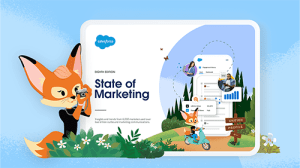We surveyed 6,000 global leaders to find out how new technologies and expectations are changing the way businesses build relationships with customers. Here are the key findings and tips for success from our newest State of Marketing report.
Over the past few years, marketing trends have forced brands to navigate uncharted waters. Shifts in customer behaviours, an economy in flux, and emerging technologies are all rocking the boat.
You can help your company weather the storm by embracing tech tools, personalising your customer interactions, preparing for a cookieless future, and prioritising collaboration with remote teams. The key is to focus on the right solution for right now.
We’ve identified four major marketing trends from Salesforce’s latest State of Marketing report. These trends are changing the way we work and how we connect with customers.

Trend 1: Tools and trust are ASEAN marketers’ priorities and challenges
New challenges call for innovative solutions. As customer expectations shift, marketers are adapting to meet audiences’ new demands. More than 90% of CMOs around the world say they must continually innovate to remain competitive. Over the past year, marketing organisations have changed their top priorities to make this happen.
As businesses are charged with doing more with less, many ASEAN marketers are looking to leverage marketing tools and technologies. The ineffective use of these tools and technologies is also the top challenge for marketers in Indonesia, the Philippines and Thailand.
Trust is another major concern — consumers are growing increasingly uncomfortable with the way their data is handled. Many marketers are working on ways of reassuring their customers and using data responsibly. Marketers in Malaysia, the Philippines and Thailand listed issues relating to trust as their top priority.

Marketing tools
Technology adoption, vanity metrics, and a disconnection between marketing and sales can slow marketers down. Many marketers are further prioritising the modernisation of their tech stack, with significant numbers around the world investing in automation and employee productivity solutions. We’ve seen customers experience a 26% boost in productivity* thanks to Slack.
Customer data
The growth of martech tools has created more data than marketers can know what to do with. With more data generated than ever before, businesses are able to target customers with personalised experiences with much greater precision. However, marketers must manage the deluge of data types that come in and balance how to personalise without crossing the ethical line.
Quick tip
If you’re implementing new tech, make sure you don’t end up using it in the same way as the old solution. Martech data is only as good as how it’s shared and implemented. To translate technology investments into business value, you should focus beyond the platforms you’re using and ensure clear, cross-team visibility of your data. Ultimately, this will unlock your tools.
Trend 2: Marketers are redefining customer engagement with smarter, targeted interactions
Data has gone from being a supporting player in a marketer’s toolkit to a critical component in marketing strategy. Marketers need to get the most from technology that uses data to provide more personalised interactions. At the same time, you may find that costs are lowered and processes become more efficient. In fact, customers have told us that Salesforce marketing tools lower their customer acquisition costs by 27%*.
Marketing organisations around the world use the following technologies:
- 90% use a customer relationship management (CRM) system
- 89% use an account-based marketing (ABM) platform
- 62% use artificial intelligence (AI)
According to our report, 80% of marketers around the world say customer experience is a key competitive differentiator. They also say that they are hungry for more connected data in order to deliver better experiences. Marketing trends show that organisations continue to increase the number of data sources they’re using each year — with a projected total of 18 in 2023.
Marketers are using technologies like CRM systems and ABM platforms to unify data and deliver targeted campaigns, while leaning on AI to integrate automation into their marketing activities. Three of the top four AI use cases are related to automation, highlighting the importance of scaling up speed and effectiveness with existing resources.
Marketers are also focused on getting the most out of limited budgets and resources to meet audiences where they are. We found that 83% of marketers around the world say their marketing organisation engages customers in real time across one or more marketing channels.
Quick tip
If you want to fully understand your customers’ demands, you’ll need a new way of using the data you have. This is why integrated tech like customer data platforms (CDPs) are more relevant than ever. Using the insights provided by these platforms will help you optimise the critical moments in your customers’ journeys and build better marketing strategies.
Trend 3: The cookieless future is pushed back, but marketers continue to prepare
The decline of third-party cookies has led marketers to look for other sources of customer data. They’re pivoting to data given freely by customers (zero-party data) and data collected directly from customers (first-party data). Marketers we surveyed in Malaysia, the Philippines, Singapore and Thailand all said that they are providing incentives to their customers to share data. In contrast, marketers in Indonesia are concentrating on investing in new technologies.

As deadlines to phase out third-party cookies continue to be delayed, 75% of marketers worldwide say they still rely on third-party data. However, they aren’t allowing this to impede progress.
Our study shows that 68% of marketers around the world have created a fully defined strategy to shift toward first-party data as they adapt to changes in privacy regulations and calls for data transparency. Streamlining the number of data sources will also help marketers be more efficient and reduce costs.
While not all third-party data is cookie-related, marketers will need to reconcile this strategy with future changes in privacy regulations. Strategies such as providing information-sharing incentives for customers can help bridge the gap by enriching customer data profiles.
The growth of data sources in the near term highlights the need for technology that will help marketers combine multiple data sources into a single view of the customer. Current marketing trends back this up: Around the world, 32% of B2B marketers say that sharing a unified view of customer data across business units is a challenge. The numbers across our region paint a slightly different picture, with some marketers struggling more than others. Only 28% of marketers in Indonesia and the Philippines say that sharing data is a challenge, for example. The number climbs to 32% in Thailand, 35% in Singapore, and up to 45% in Malaysia.

Quick tip
As we approach a future without third-party cookies, you can start to incorporate more inbound marketing into your strategies. You can offer value through content and digital experiences in exchange for your audience’s consent to use their data. After years of investing in brand marketing across various platforms, this approach may feel like a complete turnaround for B2C marketers. But building owned digital experiences will still allow you to access valuable data — with complete control as an added bonus.
Trend 4: It takes more than an investment in tools to unlock collaboration
Remote work has fundamentally changed the marketing landscape, making collaboration that much more difficult. We found that 69% of marketers around the world say it’s harder to collaborate now than before the pandemic.
Many marketers continue to juggle communications, processes, collaboration, and problem solving, all while working in a hybrid world. And they believe this marketing trend is here to stay — 70% expect investments in remote technologies to be permanent. In response, marketers are investing in collaboration technologies to ensure that work gets done, regardless of location.
Marketers who said they use the following collaboration technologies:
- Video conferencing: 46%
- Channel-based collaboration platform: 45%
- Instant messaging or chat apps: 45%
- Enterprise social networks: 44%
- Email: 43%
- Shared documents: 42%
- Voice messaging: 41%
- Phone: 38%
- Virtual whiteboards: 36%
Marketing organisations have adapted to the shifting needs of their workforce, adopting an average of four collaboration technologies to unify global marketing teams.
Taking the lead are technologies like video conferencing, channel-based collaboration platforms like Slack, instant messaging or chat apps, and enterprise social networks. While email makes it into the top five, it’s clear that communication tools that enable instant, asynchronous work are preferred when interacting with one another.
Quick tip
Integrating one platform that streamlines multiple applications and workflows can break silos and better coordinate marketing efforts. But it’s the adoption of the platform that can actually empower teams. Is the leadership team encouraging teams to use collaboration platforms, but are not actually using it themselves? Are content teams using one tool, but designers using another? To thrive in a work-from-anywhere world, collaboration requires an all-in approach to tools and processes that make teams agile and aligned.
 This post originally appeared on the U.S.-version of the Salesforce blog. *Source: 2022 Salesforce Success Metrics Global Highlights study.
This post originally appeared on the U.S.-version of the Salesforce blog. *Source: 2022 Salesforce Success Metrics Global Highlights study.
Data is from a survey of 3,706 Salesforce customers across the US, Canada, the UK, Germany, France, Australia, India, Singapore, Japan and Brazil conducted between June 8 and June 21, 2022. Results were aggregated to determine average perceived customer value from the use of Salesforce. Respondents were sourced and verified through a third-party B2B panel. Sample sizes may vary across metrics.


























